National parks
© Copyright 2025-26 by GTI Travels Pvt. Ltd.
| Lataguri NIC / Murti Safari | INR 4000 / - Jeep ( Maximum 6 Persons & 2 children (b/w - 1 to 5 years) are allowed in ONE Jeep) |
| Watch Tower Safari | INR 5200 / - Seat ( Maximum 6 Persons & 2 children (b/w - 0 to 5 years) are allowed in ONE Jeep ) |
| Zones | Start Point: Lataguri NIC ( For Medla ) | End Point: Lataguri NIC | Route Details : To Medla & Back Start Point : Murti | End Point: Chapramari WT | Route Details : Murti- Chapramari Watch Tower Start Point : Murti | End Point: Jatraprasd Watch Tower | Route Details : Murti forest Beat (Opposite Banani, WBFDCL) Start Point : Murti | End Point: Chukchuki | Route Details : Murti to Chukchuki and back |
| Timings | 06:00 AM - 07.30 AM | 8.30 AM -10.00 AM | 2.00 PM-3.30 PM | 4.30 PM - 6.00 PM (Safari Timing Varies as Season Changes) |
| Inclusions | Permission of Gorumara , Jeep, Driver, Permit and Guide Fee & Taxes. * An additional & mandatory charge of 50 per person is applied for the tribal dance during the evening safari. * Pick & drop is not included from hotels. |
Gorumara National Park, situated in the Jalpaiguri district of West Bengal, India, is a dedicated wildlife sanctuary and a reserved biodiversity zone. Established as a national park in 1992, it spans approximately 79.45 square kilometers. Renowned for its rich diversity of flora and fauna, the park is a crucial habitat for numerous endangered species, particularly the One-horned Rhinoceros. The Murti River flows along the eastern boundary of Gorumara National Park, while the Neora River marks its western edge. To the east, the Gorumara forest is adjacent to Ramsai village, near the confluence of the Murti, Diana, and Jaldhaka rivers. After their confluence, the river enters Bangladesh, where it is known as Singimari, ultimately merging with the Brahmaputra River.
Gorumara National Park is nestled in the Dooars region at the foothills of the Himalayas, forming part of the Eastern Himalayan biodiversity hotspot. The park is home to a variety of species, including the Indian rhinoceros, Asian elephant, Indian bison, leopard, sambar deer, barking deer, spotted deer, wild boar, and a wide array of birds such as peafowl, red junglefowl, and Indian hornbill. Recognized as a critical conservation area, the park is flanked by the Murti and Raidak rivers and was honored as the best-protected area in India by the Ministry of Environment and Forests in 2009.
Gorumara National Park plays an instrumental role in conserving endangered species and promoting ecotourism in the region. Visitors can embark on jeep or elephant safaris to experience the park's wildlife and natural beauty. The park is also a favored destination for birdwatching, trekking, and camping. Additionally, nearby attractions include Jaldapara Wildlife Sanctuary, Chapramari Wildlife Sanctuary, Buxa Tiger Reserve, Malbazar, Lataguri Forest, and the Tilabadi Interpretation Centers.
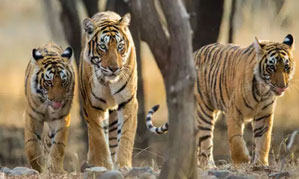
Gorumara National Park offers both jeep and elephant safaris to spot the endangered wildlife deep inside the jungle in their natural habitat. To maintain decorum amid nature and wildlife and to prevent redundant human interference inside the wild inhabitation, the forest department has methodically arranged for safari activities in strictly scheduled time slots, both for jeep and elephant safaris. Tourists can opt for advance online booking for the same to enjoy the wildlife journey according to their plan. In order to book online follow the below-mentioned details regarding jeep and elephant safaris in Gorumara National Park and their respective safari routes.
By Air: The closest airport to Gorumara National Park is Bagdogra Airport, situated approximately 80 kilometers from the park. From the airport, visitors can either hire a taxi or take a bus to reach their destination.
By Rail: The closest railway station to Gorumara National Park is Chalsa. However, since not all major trains stop at Chalsa, Malbazar is the more convenient option. It takes about 45 minutes to reach Gorumara National Park from Malbazar railway station. Alternatively, visitors can disembark at NJP railway station, which is approximately a one-and-a-half-hour drive to the national park.
By Road: Gorumara National Park is easily accessible by road from major cities in West Bengal. Visitors can reach the park by taking a bus or hiring a taxi from Siliguri, located approximately 80 kilometers away.
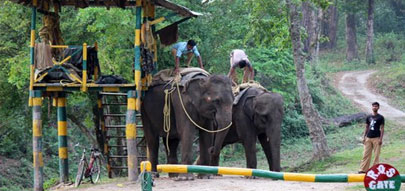
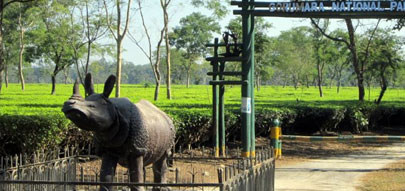
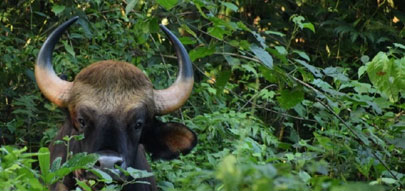
Gorumara National Park experiences a tropical climate due to its location at the foothills of the Himalayas. During winter, the days are mildly cold, while the nights can become significantly chilly. In contrast, summer days tend to be warm, with nights offering comparatively cooler temperatures. The monsoon season brings moderate to heavy rainfall, creating a mix of warm, humid, and cool weather conditions.
Temperature variations range from 10°C to 21°C between November and February, 24°C to 27°C from March to April, and 27°C to 37°C from May to October. Rainfall is most frequent from mid-May to mid-October, with an average annual precipitation of 382 cm. Gorumara National Park is open to visitors from October to June but remains closed during the monsoon season, from June to September, to prevent any potential hazards. For those looking to enjoy a safari amidst pleasant weather, the ideal time to visit Gorumara is between November and March.
Gorumara National Park is one of the popular wildlife destinations in India, known for its sound biodiversity and scenic beauty. It sparkles like a jewel on the crown of Dooars in North Bengal. Here are some of the top tourist activities in Gorumara National Park:
Jeep Safari: Gorumara National Park offers jeep safaris for tourists in morning and evening shifts. The jeep safari lasts for about 1&½ hours and it is the best option to explore deep inside the forest of Gorumara. A maximum of 6 adults and 2 children, below the age of 5, are allowed in one jeep along with the driver and the guide.
Elephant Safari: The Elephant Safari in Gorumara National Park is available to tourists, albeit with a limited number of slots. The safari begins and concludes at the Dhupjhora Elephant Camp and is offered in three sessions - two in the morning and one in the evening. During the safari, visitors are taken through the dense forests of the national park, crossing the Jaldhaka River. The maximum capacity for the elephant safari is two guests, accompanied by a mahout.
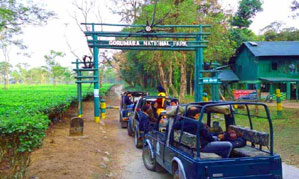
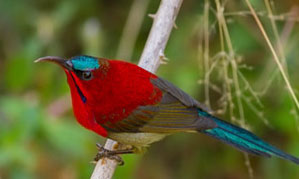
Birds Watching: The park is home to a great many species of birds, making it a paradise for birdwatchers. The dense forest of Gorumara houses various species of avifauna in abundance. The forest is ideal for bird watchers and photographers to spot and capture pictures of rare species of birds. Gorumara is also the abode of migratory birds, that settle in the forest, especially during the winter season.
Watchtower Visit: Gorumara National Park features several strategically placed watchtowers designed to enhance visitors' ability to observe wildlife and their natural habitats. These watchtowers are named as - Jatraprasad, Chukchuk, Rhino Observation Point, Chandrachur, Chapramari and Medla. Each of these watchtowers provides a distinct perspective, offering unique opportunities to observe various species of animals and birds in their natural environment.
Chukchuk Watch Tower: - Situated on the periphery of Gorumara National Park, the Chukchuk Watch Tower provides an excellent vantage point for birdwatching.
Chandrachur Watch Tower - Positioned near the Murti Forest Bungalow along the Murti River, the Chandrachur Watch Tower, also known as the Khunia Watch Tower, offers an impressive panoramic view from its summit.
Jatraprasad Watch Tower - Erected in memory of a beloved elephant that once resided in the park, the Jatraprasad Watch Tower is centrally located within the national park and provides a 360-degree view of the surrounding landscape.
Chapramari Watch Tower - Situated at another edge of Gorumara National Park, the Chapramari Watch Tower affords a sweeping view of the surrounding wilderness.
Medla Watch Tower - Positioned near the Murti Riverbanks, the Medla Watch Tower offers opportunities to observe elephants playing in the river.
Rhino Observation Point - Adjacent to a salt pit, the Rhino Observation Point is conducive to frequent sightings of both elephants and one-horned rhinoceroses.
Trekking opportunities Gorumara National Park in Lataguri leads to Jayanti Mahakkal Caves, Near the Buxa Tiger Reserve. The picturesque forest trails in proximity to Gorumara National Park offer an excellent opportunity for an invigorating trek. One notable trail leads to a nearby captivating tribal settlement renowned for its pristine natural beauty.
Jaldhaka : Jaldhaka, though relatively unknown to many, represents an ideal destination for tourists seeking a tranquil retreat. Covering a distance of 62 km, one can take in breathtaking views of majestic hills, lush valleys, and scenic landscapes. The monsoon season is particularly recommended for visiting, as it enhances the region's natural beauty. The charm of this area is bound to dispel any doubts about its renowned appeal in Lataguri.
Chapramari Wildlife Sanctuary : Chapramari Forest, located in the Western Dooars region, is renowned for its substantial population of Indian elephants. The Chapramari Wildlife Sanctuary encompasses an area of just 9.6 square kilometers. It is situated adjacent to National Highway 31A, which links the Northeast with the rest of India. Positioned to the north of Gorumara National Park, it lies within the Nagrakata block of the Jalpaiguri district, along the eastern bank of the Murti River.
Kalipur Eco Village : Kalipur Eco Village represents a distinctive model of ecotourism in the Dooars region. Situated at the core of Gorumara National Park and atop the elevated floodplains of the Murti and Jaldhaka rivers, Kalipur Eco Village is surrounded by a wealth of natural landscapes and wildlife. This forest bungalow is located just a few steps away from the Medla Watch Tower.
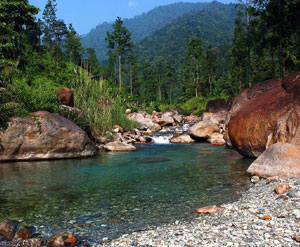

Murti River : Adjacent to the Medla Watch Tower, the Murti River meanders through the dense forest. It is not uncommon to observe wildlife such as elephants, rhinoceroses, and deer frequenting the riverbank to quench their thirst.
Chalsa : Situated at the foothills of the majestic Himalayas, Chalsa is a village in the Jalpaiguri district of West Bengal, located just 14 kilometers from Gorumara National Park. Enveloped by lush foliage, extensive tea plantations, and towering hills, the village is partially encompassed by Gorumara National Park and bordered by the Chapramari Wildlife Sanctuary. This locale offers an ideal setting for observing diverse species of animals and birds, making it a renowned destination for photographers, nature enthusiasts, and wildlife aficionados.
Lataguri Nature Interpretation Centre : Adjacent to Gorumara National Park lies the Lataguri Nature Interpretation Centre. This facility offers an opportunity to observe the diverse flora and fauna of Gorumara through an engaging light and sound presentation. The centre enhances the overall experience of the area by providing educational insights uniquely and innovatively.